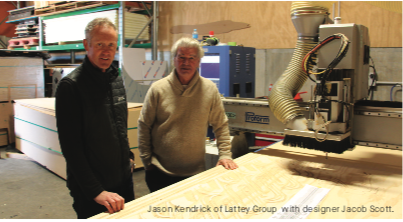Visitors arriving to the redeveloped Hawke’s Bay Airport will be enveloped by a sense of place and a connection to the special character of the land the airport is based on in Ahuriri.
The airport is on schedule to celebrate the opening of the new terminal in February 2021, after a $20.2 million expansion project that has seen the terminal nearly triple in size.
Although there has been a couple of set backs, including COVID-19 lockdown, the final stages are now being completed with the centralized hospitality and commercial hub as well as the Air New Zealand lounge.
Local artist Jacob Scott, on behalf of local hapu Mana Ahuriri, has been involved in the project since its inception. He has been engaged to design the interior ceiling which when finished will connect visitors to the region and its people by telling the stories of the local area, Ahuriri and its connection to other places in the world.
The whakairo panel installation will form a part of the larger redevelopment project which incorporates further storytelling into other elements of the building’s structure including the outdoor entrance forecourt and the road entry works on Watchman Road.
Jacob says the airport is not only an active public space but serves as an airport that can project artistic ideas on a massive, public scale.
The artwork comprises over 250 plywood panels, approximately 180 running meters, carved using digital machining technology by Lattey Group in Hastings. The completed panels will be suspended above visitors as they enter and move through the airport terminal, forming a single continuous art installation through the interior of the terminal.
In working with local iwi to identify content for the designs, a decision to focus on ideas connected to the airport locality and purpose was made.
The inspiration for the design comes from the Kuaka, a native bird of the area and is a symbol of passage or voyage, of strength and endurance and of journeys and discovery as the Kuaka travels 29,00kms to Alaska and back each year. At the end of their journey the Kuaka feed in the estuary surrounding the airport and the birds provide a link to the world around us.
The fact that the birds travel this far to feed, in this place is significant and as Ngahiwi Tomoana, Chairman Ngāti Kahungunu says “the Kuaka make the longest flight of any man creature or even man-made plane without refueling. This little bird arrives with the wisdom of both worlds, both sides of the veil, that of the living, and that of where those who have passed on dwell”.
As a site of departure the airport is Hawke’s Bays connection with the wider world. It is a lift off point for connections made through trade, enterprise, social and cultural connections.
Jacob says the story has been ever- evolving since the initial concepts were developed prior to construction commencing. He says interwoven into the design is the formation of the land, which underwent significant change with the 1931 Hawke’s Bay earthquake.
Further inspiration has also been the impact of COVID-19, which impacted on the aviation sector grounding flights globally.
“There has been recent turmoil, but we are welcoming people back to Hawke’s Bay again and our people will also take flight and explore the world again, just like the kuaka. We can take flight and go anywhere and anyone will be able to come here from their place too.
Hawke’s Bay Airport chief executive Stuart Ainslie says the design brief was outlined in three key priorities; Express our unique regional identity, Uplift the profile of creative practice in the region and Improve visibility of creatives on a national and international level were identified.
“This project exemplifies how these aspirations are enacted and it will provide a unique setting that will welcome visitors on holiday and for business to the region.”


